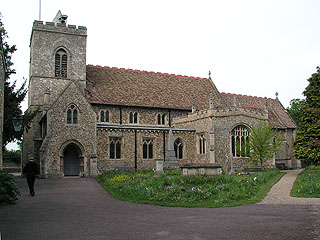The first thing I thought when I saw the church noticeboard was 'That's a wierd dedication - must be a scholarly Victorian vicar who was bored of yet another St Mary'. It's true that this is one of only two churches in the UK dedicated to St Vigor (the other is at Stratton-on-the-Fosse in the Mendips), but according to the guidebook, the dedication is original.
English accounts seem to concentrate on the more boring aspects of his existence - he was a 6th century bishop of Bayeux who opposed paganism, built a church on the site of a pagan temple, and founded a monastery. Hardly very original stuff. In writing up this entry, though, I remembered there being a more exciting story involving dragons, so I went off and investigated. The French seem more prepared to recount the gory details. On one website we are told with great relish that there was a dragon which 'brûlait de son souffle tout ce qui vivait en forêt de Cerisy'. This forest belonged to a certain nobleman called Volusianus, and he asked the bishop for his help. Vigor went off and managed to calm the beast by making the sign of the cross in front of it. He was then able to tie his stole around its neck and then - in what strikes me as an act of singular bad faith with the poor dragon - led it into the sea, where it either was swallowed or dissolved, depending on whether you trust my French or Google's. Volusianus was so impressed that he gave Cerisy to Vigor, where he founded his monastery. So, it all ended happily ever after - except for the dragon, of course.
None of this explains why there should be a church dedicated to him in the middle of Cambridgeshire. Whether or not the dedication was revamped under the Victorians, though, the church certainly was. The tower is 13th century at its base but the upper stages are all Victorian, and almost all of the interior has either been heavily restored or rebuilt.
Still, for such a heavily restored structure, St Vigors contains a surprisingly interesting variety of things to see. The Victorian screen is really quite good. There's a big chest-tomb to an Edward Wood (d.1633) and his wife, which has their effigies reclining on the top. A rather crude version of the sort of thing one sees at Framlingham in Suffolk, or at Landwade. There are lots of little brasses lying around, and a life size one in the chancel showing a man wearing a cope, with some of his canopy remaining. He is William of Fulbourn, a late 14th century rector here, and also chaplain to Edward III and a canon of St Paul's Cathedral in London. It is apparently the earliest representation on an English brass of a cope, which you might find interesting. There's another tomb in the north wall with a much mutilated full length figure under a sort of table, with a wide canopy over the whole recess: it is now used as a recess. Pevsner recounts the local story that it is a monument to John Careway, another rector here who died in 1443. Finally, the pulpit is a good old one containing panels with two 15th century paintings of saints - rescued, perhaps, from the screen. I couldn't identify them. There's also a rather sweet appliqué image on the nave altar cloth of a bishop with a leashed dragon. Poor dragon! It looks so harmless and docile with its collar of white satin: rather upsetting really.
St Vigor was open when we visited
